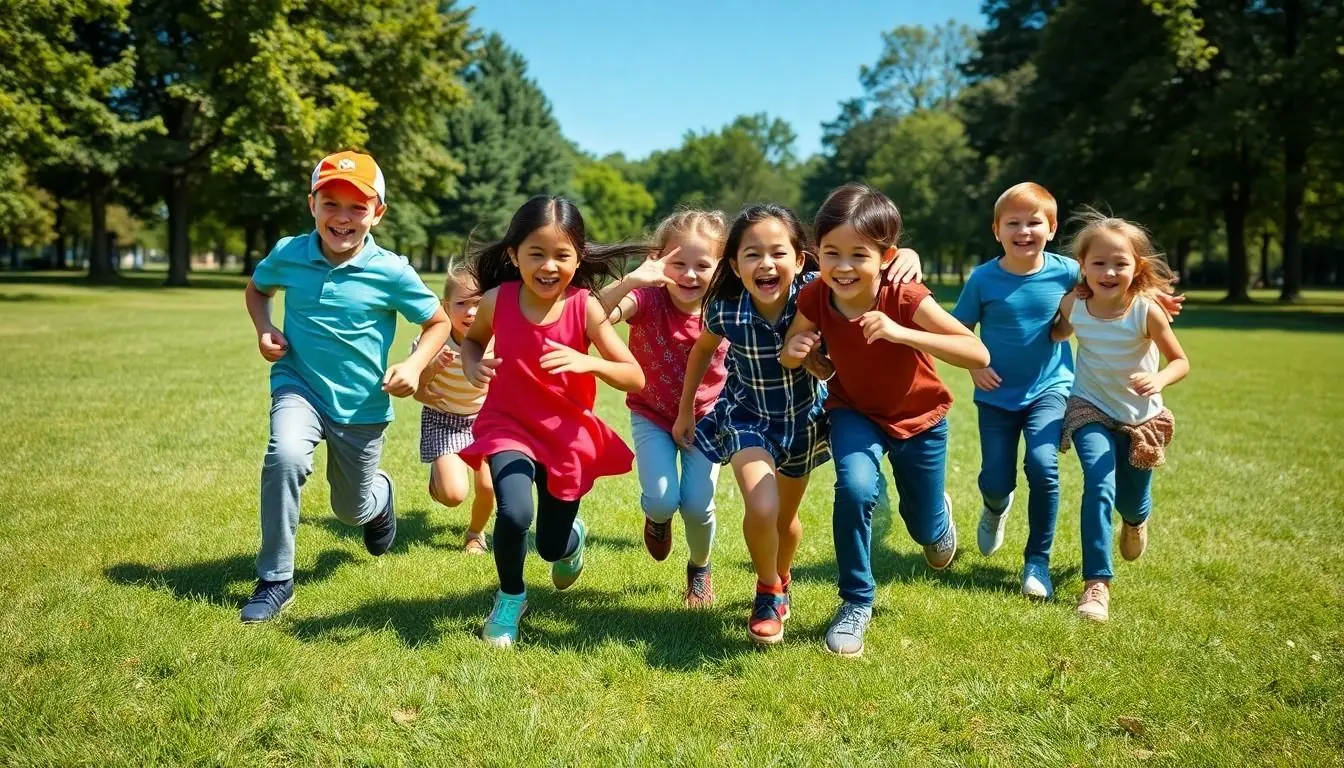When it comes to keeping kids entertained, nothing beats the thrill of large group games. Picture this: a bunch of energetic kids running around, laughing, and bonding over some friendly competition. It’s the perfect recipe for fun, and it might just tire them out enough for a peaceful evening at home.
Table of Contents
ToggleBenefits Of Large Group Games For Kids
Large group games offer numerous advantages for children’s development. These activities promote interaction, teamwork, and physical well-being.
Social Skills Development
Participation in large group games fosters social skills among kids. Children learn to communicate effectively with peers, improving their verbal and non-verbal interactions. They practice cooperation while working toward common goals, which strengthens friendships and social bonds. Such games also teach conflict resolution, as kids encounter disagreements and learn strategies to resolve them. Observing others enhances empathy and respect, essential traits for successful social interaction.
Physical Activity Boost
Large group games significantly increase physical activity levels. Kids engage in running, jumping, and other movements, promoting cardiovascular health and building strength. These activities help combat sedentary lifestyles by keeping children active and energized. Moreover, regular participation leads to improved coordination and motor skills. As kids play, they’ll also discover the joys of being outdoors, which can reduce stress and elevate mood.
Cognitive Skills Enhancement
Engaging in large group games sharpens cognitive abilities in children. Games often require critical thinking and strategy, which enhances problem-solving skills. Kids must quickly process information and make decisions during gameplay, promoting mental agility. Furthermore, collaboration within teams encourages creative thinking and adaptability as children learn to navigate different roles. By playing, kids not only have fun but also exercise their brains in a stimulating environment.
Popular Large Group Games

Large group games engage kids and enhance their social skills. Many options exist for both outdoor play and indoor activities.
Classic Outdoor Games
Tag offers endless fun, allowing children to chase and evade one another. Capture the Flag promotes teamwork as players strategize to outsmart opponents. Another option, Red Rover, encourages physical activity while emphasizing cooperation. Hide and Seek provides excitement as kids search for each other, fostering social interaction. Each of these games cultivates friendships and develops vital communication skills.
Indoor Group Games
Charades encourages creativity as players act out words or phrases without speaking. Another popular choice, Mafia, stimulates critical thinking and deduction skills as participants determine who among them plays the role of the “mafia.” Additionally, Bingo involves recognition and listening skills, making it suitable for various age groups. Pictionary blends drawing with guessing, enhancing creativity and interaction among players. Such games keep children engaged and entertained, even when indoors.
Cooperative Games
In cooperative games, children work together toward shared goals. For example, the Human Knot encourages teamwork, as players untangle themselves without breaking hands. The Trust Fall builds trust and camaraderie, promoting supportive relationships. Another option, the Great Egg Drop, invites creativity as teams devise ways to protect eggs during a drop. These activities create a sense of community among participants, strengthening their social bonds.
Tips For Organizing Large Group Games
Organizing large group games requires careful planning to ensure a fun and safe environment for children. Keep these key aspects in mind for effective game execution.
Safety Considerations
Prioritize safety to create a secure playing environment. Inspect the playing area for hazards like sharp objects or uneven terrain. Establish clear rules to prevent accidents and ensure every child’s understanding of game dynamics. Provide constant supervision by adults or responsible teens to monitor activities. Equip children with appropriate gear or equipment when needed, ensuring a safe experience for everyone involved.
Space Requirements
Identify suitable space to accommodate group activities. Select areas that provide enough room for movement and interaction without causing overcrowding. Open fields or large indoor spaces work best for outdoor and indoor games. Ensure there’s space for children to spread out, minimizing the risk of collisions. Mark boundaries clearly to help define game zones, preventing confusion during play.
Age Appropriateness
Assess the age range of participants to choose suitable games. Consider skill levels and physical capabilities when selecting activities. Games should challenge children without becoming overly difficult or frustrating. Tailor rules and game formats to match ages, ensuring engagement for younger and older children alike. Invite input from older kids when possible, allowing them to adapt games for a more inclusive experience.
Adaptations For Different Age Groups
Creating age-appropriate adaptations for large group games ensures that all children engage and enjoy the activities. Each age group brings unique needs and capabilities.
Games For Younger Kids
Games for younger kids should focus on simplicity and physical activity. Activities like Duck Duck Goose provide fun while encouraging running and quick decision-making. Additionally, simple relay races enhance coordination and teamwork. Tag games help develop social skills as children learn to take turns and follow rules. Structure the games to include clear instructions and short durations, keeping younger children engaged and preventing frustration. Elements of music can also be integrated to enhance excitement.
Games For Tweens
Tweens thrive on slightly more complex games that challenge their social skills and creativity. Capture the Flag remains a favorite, combining strategy with physical play. Incorporating elements like scavenger hunts can stimulate their problem-solving abilities while promoting teamwork. Avoid overly competitive scenarios to minimize discouragement among participants. Include rules that encourage creativity, like designing team flags or using props to make the game more engaging. Maintaining a balance between structured and unstructured play fosters an enjoyable atmosphere.
Games For Teens
Teenagers often appreciate games that offer higher stakes and deeper interactions. Features of classic games like Mafia or Werewolf engage critical thinking and social deduction. Additionally, outdoor sports such as Ultimate Frisbee promote both competition and camaraderie. Ensure that the games allow for leadership roles and collaboration, enhancing teamwork. Creating a mix of competition and creativity can keep teens interested. Incorporate technology, like using apps to track scores or challenge teams, to cater to their interests.
Large group games for kids offer a dynamic way to foster social skills and physical activity while keeping children engaged and entertained. Through these activities, kids learn valuable lessons in teamwork and communication that can benefit them throughout their lives. The variety of games available ensures that there’s something suitable for every age group, making it easy to adapt activities for different skill levels.
By prioritizing safety and age appropriateness, organizers can create an inclusive environment where all children can thrive. With the right mix of fun and learning, large group games can significantly enhance children’s development and create lasting memories.



